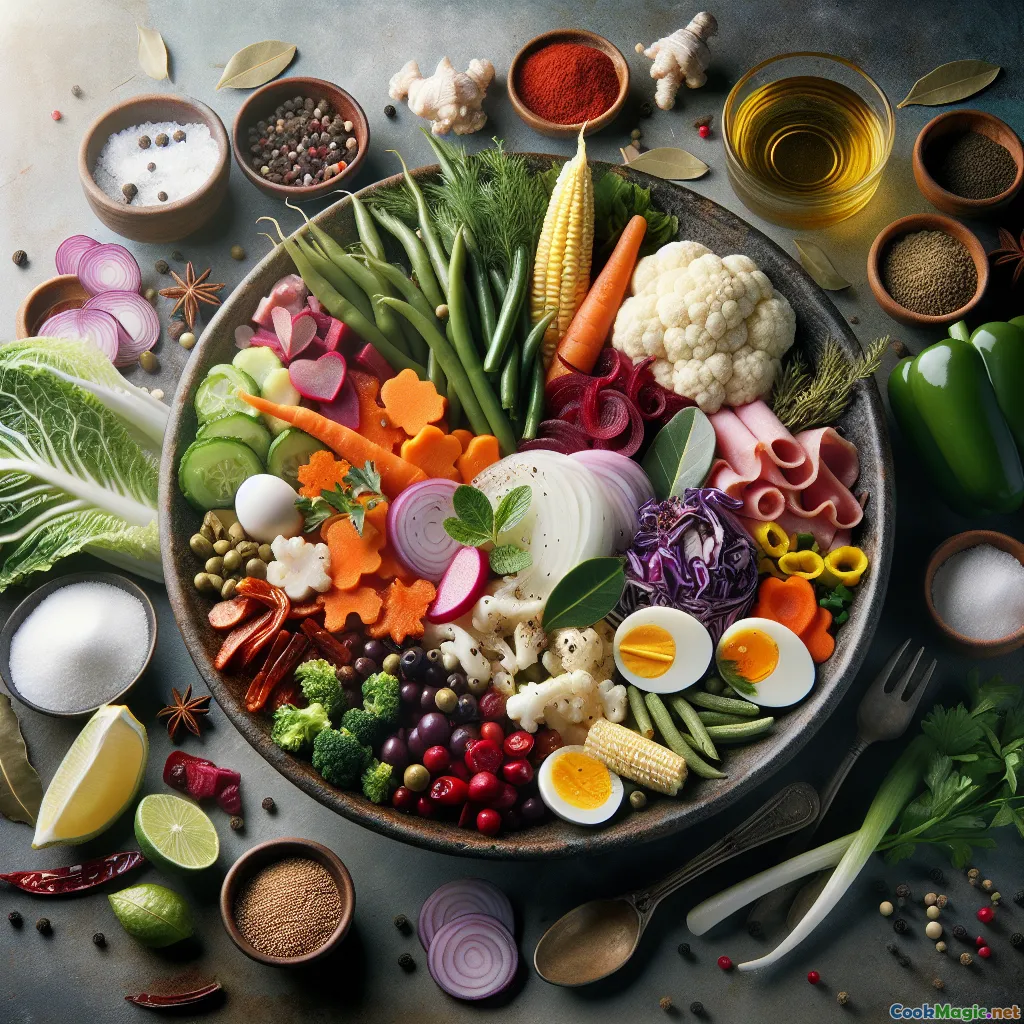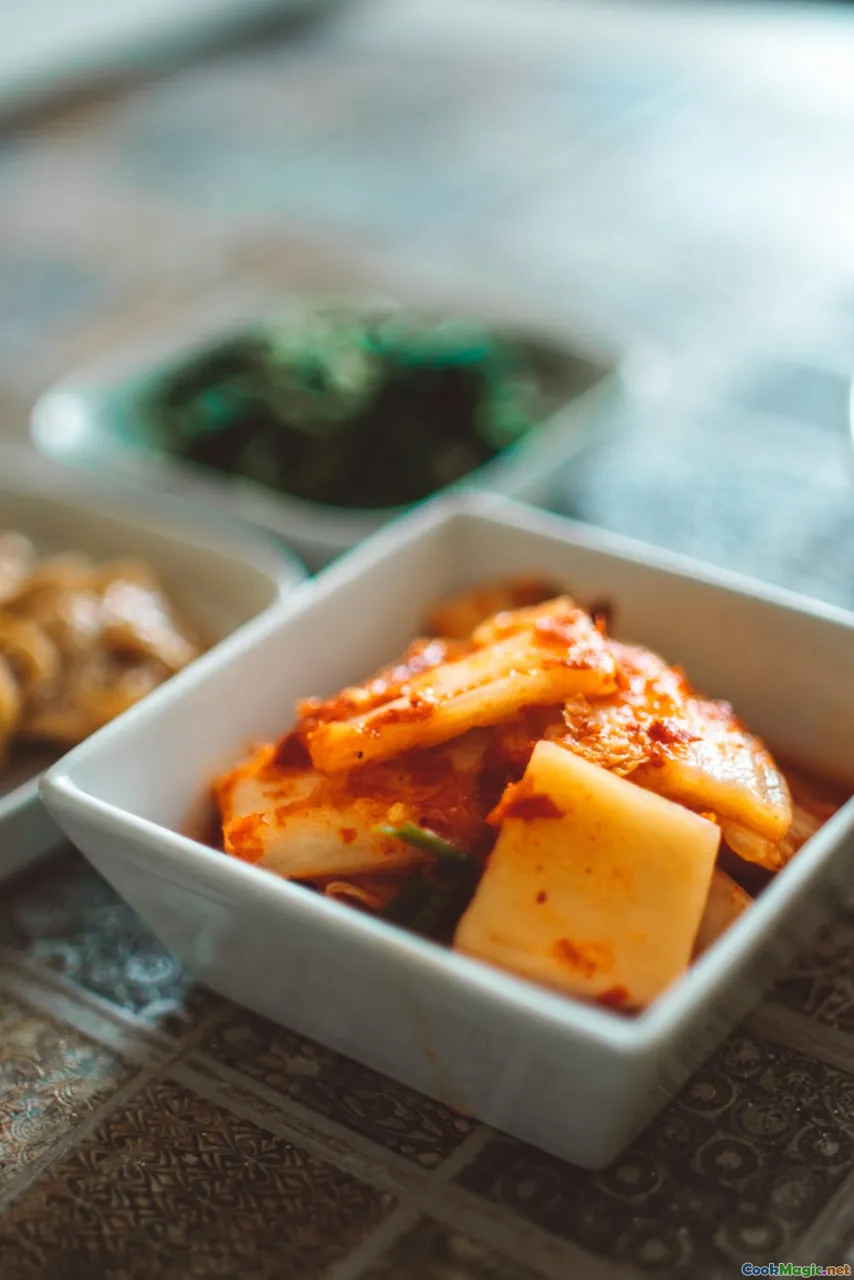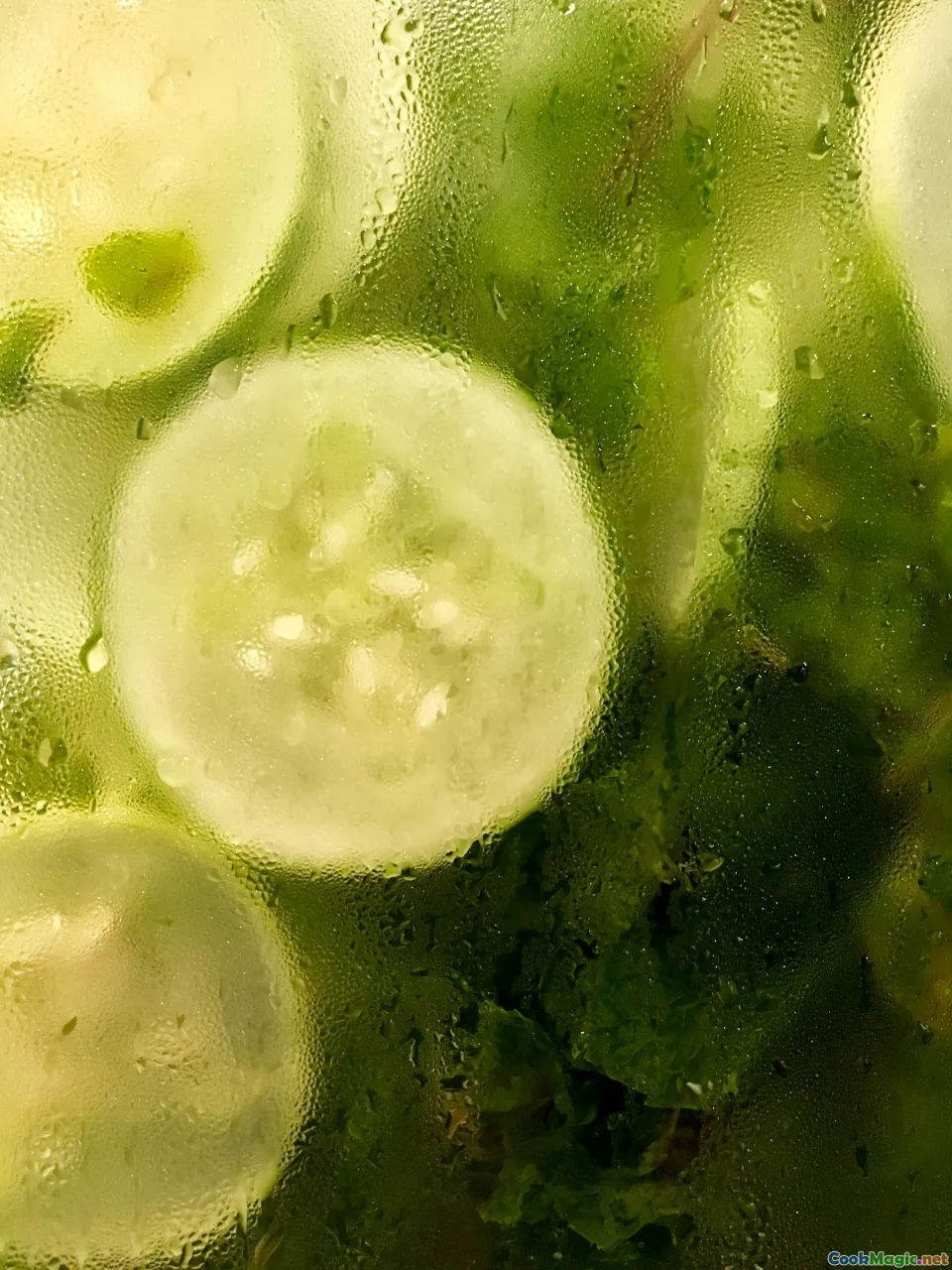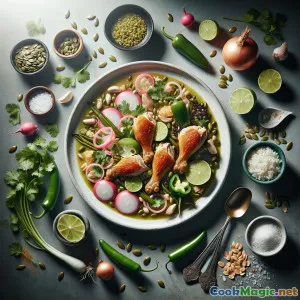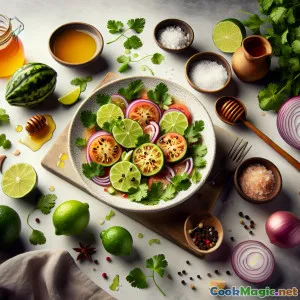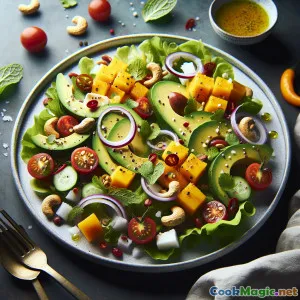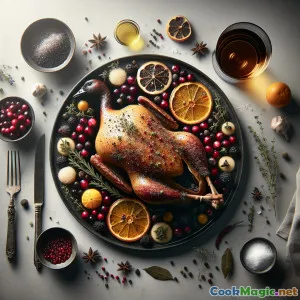
All Saints Day के लिए ग्वाटेमाला का रंगीन Fiambre
(Guatemalan Rainbow Fiambre for All Saints Day)
(0 समीक्षाएँ)सामग्री
-
500 ml सफेद सिरका
(Base for the pickling brine (curtido))
-
500 ml पानी
(Dilutes the brine for balance)
-
80 grams चीनी
(Balances acidity in the brine)
-
20 grams कोषेर नमक
(Seasons brine and vegetables)
-
2 leaves तेज पत्ते
(Fragrant herbal note in brine)
-
8 whole ऑलस्पाइस बेरीज
(Traditional warm spice for fiambre brine)
-
12 whole काली मिर्च के दाने
(धीमी आंच डालें)
-
1 tsp सरसों के बीज
(Crunchy bursts of flavor)
-
1 tsp सूखी अजवाइन
(Herbal backbone for curtido)
-
0.5 tsp सूखी थाइम
(Subtle earthiness)
-
4 whole सामग्री लौंग
(Use sparingly for aroma)
-
300 grams गाजर
(Thinly sliced on the bias for color and crunch)
-
300 grams फूलगोभी के फूल
(Break into bite-sized pieces)
-
200 grams हरी फलियाँ
(Trimmed; blanch to keep crisp)
-
200 grams लाल गोभी
(Shredded for vibrant color and texture)
-
250 grams पकी हुई चुकंदर
(Diced; gives fiambre its rosy hue (rojo))
-
200 grams कैन्ड बेबी कॉर्न
(Drained; adds sweetness)
-
100 grams हरा जैतून
(Pitted; briny accent)
-
30 grams कैपर
(Drained; bright salty pops)
-
150 grams अचार वाले मोती प्याज़
(Adds tang and crunch)
-
150 grams पका हुआ चोरिज़ो
(Sliced; use mild or spicy to taste)
-
150 grams स्लैमी
(पतला स्लाइस)
-
200 grams पका हुआ हैम
(Sliced; any good-quality deli ham)
-
400 grams भुना हुआ चिकन
(Shredded; leftovers work well)
-
150 grams मोर्ताडेला
(Sliced; optional but classic in some families)
-
200 grams Queso fresco
(Cubed; or use panela or mild farmer cheese)
-
4 large सुखे उबले अंडे
(Quartered for garnish)
-
200 grams झींगा
(Cooked and peeled; omit for non–seafood version)
-
2 heads रोमैने लेट्यू스
(Leaves separated; base for plating)
-
30 grams ताजा अजमोद
(Chopped; for freshness and garnish)
-
1 large लाल शिमला मिर्च
(Roasted and sliced into strips)
-
100 grams मूली
(Thinly sliced for a peppery bite)
-
3 tbsp जैतून का तेल
(For light dressing)
-
1 tbsp डिज़ॉन सरसों
(Emulsifies the dressing)
-
3 tbsp नींबू का रस
(Freshly squeezed; brightens flavors)
-
1 tbsp अन्नाटो तेल (अचीओटे)
(Optional color and earthy note)
(Base for the pickling brine (curtido))
(Dilutes the brine for balance)
(Balances acidity in the brine)
(Seasons brine and vegetables)
(Fragrant herbal note in brine)
(Traditional warm spice for fiambre brine)
(धीमी आंच डालें)
(Crunchy bursts of flavor)
(Herbal backbone for curtido)
(Subtle earthiness)
(Use sparingly for aroma)
(Thinly sliced on the bias for color and crunch)
(Break into bite-sized pieces)
(Trimmed; blanch to keep crisp)
(Shredded for vibrant color and texture)
(Diced; gives fiambre its rosy hue (rojo))
(Drained; adds sweetness)
(Pitted; briny accent)
(Drained; bright salty pops)
(Adds tang and crunch)
(Sliced; use mild or spicy to taste)
(पतला स्लाइस)
(Sliced; any good-quality deli ham)
(Shredded; leftovers work well)
(Sliced; optional but classic in some families)
(Cubed; or use panela or mild farmer cheese)
(Quartered for garnish)
(Cooked and peeled; omit for non–seafood version)
(Leaves separated; base for plating)
(Chopped; for freshness and garnish)
(Roasted and sliced into strips)
(Thinly sliced for a peppery bite)
(For light dressing)
(Emulsifies the dressing)
(Freshly squeezed; brightens flavors)
(Optional color and earthy note)
पोषण
- परोसने की संख्या: 8
- सेवा आकार: 1 प्लेट (350ग्राम)
- Calories: 650 kcal
- Carbohydrates: 0 g
- Protein: 38 g
- Fat: 36 g
- Fiber: 7 g
- Sugar: 12 g
- Sodium: 1400 mg
- Cholesterol: 180 mg
- Calcium: 250 mg
- Iron: 3.5 mg
निर्देश
-
1 - Make the pickling brine:
In a pot, combine vinegar, water, sugar, salt, bay leaves, allspice, peppercorns, mustard seeds, oregano, thyme, and cloves. Bring to a brief simmer, then remove from heat.
-
2 - Blanch firm vegetables:
Blanch carrots, cauliflower, and green beans in boiling salted water 1–2 minutes each. Shock in ice water to keep crisp-tender and vibrant.
-
3 - Pickle the Vegetables:
Place blanched vegetables, red cabbage, beets, baby corn, olives, capers, and pearl onions in a large bowl. Pour warm brine over and let stand 30 minutes, then cool; strain, reserving 1 cup brine.
-
4 - Prepare proteins:
Cook chorizo and shrimp if needed; cool. Slice deli meats and chorizo into ribbons, shred roast chicken, and cube queso fresco.
-
5 - Prep Garnishes:
Quarter hard-boiled eggs. Roast and slice red bell pepper if using. Slice radishes thinly. Chop parsley.
-
6 - Whisk light dressing:
Whisk olive oil, Dijon, lime juice, 3–4 tbsp reserved brine, and annatto oil (optional) to a thin emulsion.
-
7 - Toss vegetables:
Gently toss the pickled vegetables with half the dressing. Taste and adjust with extra brine for brightness or oil for roundness.
-
8 - Create the lettuce base:
Line a large platter or shallow tray with crisp romaine leaves to form an edible base and visual frame.
-
9 - Arrange proteins artistically:
Layer chicken, ham, salami, mortadella, chorizo, and shrimp in color blocks or concentric rings over the lettuce.
-
10 - Add cheeses and eggs:
Scatter queso fresco cubes throughout and nestle egg quarters evenly to balance color and texture.
-
11 - Finish with vegetables and herbs:
Mound dressed pickled vegetables over and around meats. Sprinkle parsley, roasted pepper strips, and radishes. Drizzle remaining dressing.
-
12 - Chill to meld flavors:
Cover and chill at least 45 minutes (up to overnight). This resting time is essential for the characteristic fiambre flavor.
-
13 - Serve family-style:
Bring to the table cold. Offer extra brine and lime wedges on the side. Serve generous, colorful portions.
In a pot, combine vinegar, water, sugar, salt, bay leaves, allspice, peppercorns, mustard seeds, oregano, thyme, and cloves. Bring to a brief simmer, then remove from heat.
Blanch carrots, cauliflower, and green beans in boiling salted water 1–2 minutes each. Shock in ice water to keep crisp-tender and vibrant.
Place blanched vegetables, red cabbage, beets, baby corn, olives, capers, and pearl onions in a large bowl. Pour warm brine over and let stand 30 minutes, then cool; strain, reserving 1 cup brine.
Cook chorizo and shrimp if needed; cool. Slice deli meats and chorizo into ribbons, shred roast chicken, and cube queso fresco.
Quarter hard-boiled eggs. Roast and slice red bell pepper if using. Slice radishes thinly. Chop parsley.
Whisk olive oil, Dijon, lime juice, 3–4 tbsp reserved brine, and annatto oil (optional) to a thin emulsion.
Gently toss the pickled vegetables with half the dressing. Taste and adjust with extra brine for brightness or oil for roundness.
Line a large platter or shallow tray with crisp romaine leaves to form an edible base and visual frame.
Layer chicken, ham, salami, mortadella, chorizo, and shrimp in color blocks or concentric rings over the lettuce.
Scatter queso fresco cubes throughout and nestle egg quarters evenly to balance color and texture.
Mound dressed pickled vegetables over and around meats. Sprinkle parsley, roasted pepper strips, and radishes. Drizzle remaining dressing.
Cover and chill at least 45 minutes (up to overnight). This resting time is essential for the characteristic fiambre flavor.
Bring to the table cold. Offer extra brine and lime wedges on the side. Serve generous, colorful portions.
All Saints Day के लिए ग्वाटेमाला का रंगीन Fiambre :के बारे में ज़्यादा जानकारी
About This Dish
Fiambre Colorido de Todos Santos is Guatemala’s exuberant, cold composed salad traditionally served on November 1st (All Saints Day) and November 2nd (All Souls Day). More than a recipe, it’s a vibrant edible tapestry: pickled vegetables (curtido), an assortment of cured and cooked meats, cheeses, and eggs, all layered over crisp lettuce and finished with briny brightness. Families gather around it after visiting cemeteries and decorating graves with marigolds, paper kites, and candles—an act of remembrance and joyful continuity.
What makes fiambre special is how it honors memory and resourcefulness. Each family passes down its version, some closely guarded. There are two broad categories: fiambre rojo (often tinted by beets, with a rosy glow) and fiambre blanco (lighter, sometimes without the beet brine). This “Colorido” approach celebrates the red style, relying on beets for hue and a balanced homemade brine that’s gently spiced with allspice, oregano, and bay leaf.
Flavor and Texture
Fiambre is about contrast. Crisp-tender cauliflower and green beans mingling with juicy olives and capers; silky mortadella and hearty roast chicken next to crumbly, milky queso fresco; peppery radish slices and herbal parsley to finish. The dressing is delicate—more a whisper than a blanket—allowing the brine’s tang to lead while olive oil and Dijon lend polish.
Tips & Notes
- Plan ahead: Fiambre improves after resting. Chilling for at least 45 minutes is good; overnight is even better. Keep wet and dry components separate if resting longer than a few hours to preserve textures.
- Knife work matters: Slice meats and vegetables consistently for clean layers and easy serving. Use a sharp knife for neat cuts through eggs and cheese.
- Brine control: Reserve extra brine and add to taste. More brine sharpens and brightens; a touch more oil rounds and softens.
- Customize proteins: While many families include sausages, ham, and cold cuts, you can emphasize poultry for a lighter profile or omit seafood for simplicity. The shrimp is optional and can be swapped for additional chicken or even hearts of palm.
- Vegetarian path: Skip meats and seafood. Load up on beans (chickpeas or white beans), grilled mushrooms, marinated artichokes, and extra cheeses like panela. The result remains festive and deeply satisfying.
- Color strategy: Cluster ingredients by color—strips of red pepper, rings of eggs, mounds of beet-stained cauliflower—so each serving captures the full spectrum.
- Food safety: Cool cooked items fully before assembling; keep the dish cold (below 4°C/40°F). If serving outdoors, use chilled platters.
- Make-ahead: The pickled vegetables keep well for 3–4 days in the refrigerator. Slice meats and assemble the platter up to 1 day ahead; add lettuce base and delicate garnishes the day of serving.
Cultural Significance
Fiambre is inseparable from Todos Santos in Guatemala. After cemetery visits—sometimes accompanied by giant kite festivals in Sumpango and Santiago Sacatepéquez—families share fiambre as a living bridge to those they honor. Each ingredient, often saved or specially prepared, tells a story: a favorite cold cut of a grandparent, the beets a mother always insisted on, or the specific herb a family swears by. No two fiambres are alike; that individuality is the tradition. It’s about abundance and remembrance, set cold on the table for all to enjoy together.
Unique Aspects
- Layered assembly: Unlike tossed salads, fiambre is meticulously arranged, making every slice of the platter a curated bite.
- Balanced brine: The curtido’s spice profile leans aromatic rather than fiery, distinct from other Latin pickles.
- Dual identity: It’s both a salad and a charcuterie mosaic—hearty yet refreshing, ideal for warm midday gatherings.
Substitutions & Variations
- Cheese: Queso fresco can be swapped with panela, farmer cheese, or mild feta (soak feta briefly to reduce saltiness).
- Vegetables: If you can’t find baby corn or pearl onions, use sliced cornichons and thinly sliced red onion lightly pickled in the same brine.
- Herbs: Parsley is classic, but cilantro adds a fresh, citrusy angle.
- Dressing: Some families add a spoonful of mayonnaise for creaminess; keep it light so brine still shines.
Serving & Presentation
Use a broad, shallow platter. Begin with a frame of romaine leaves. Arrange proteins in bands or concentric circles. Mound the pickled vegetables in the center, then accent with egg quarters, radish coins, roasted pepper strips, and a final dusting of parsley. Bring extra brine and lime wedges to the table so guests can personalize acidity. Serve with crusty bread or simple corn tortillas to catch the juices.
Storage
Keep leftovers covered and chilled up to 3 days. The vegetables may continue to take on color from beets; meats remain flavorful though slightly firmer from the brine—delightful in sandwiches the following day.
Personal Notes
Fiambre rewards thoughtfulness more than precision. Taste as you go, especially with the brine. Aim for buoyant acidity, light sweetness, and aromatic spice that lifts rather than dominates. When the platter lands, it should feel like a celebration in technicolor—beautiful to behold, generous to share, and grounded in memory. That’s the heart of Fiambre Colorido de Todos Santos.
